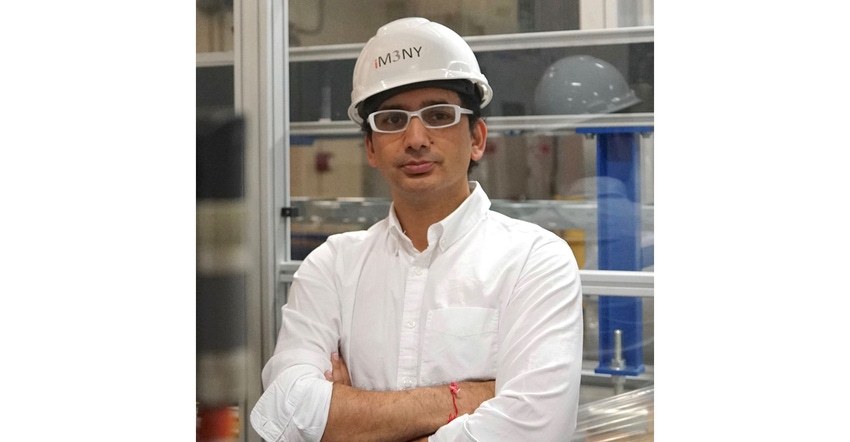Battery makers are innovating to meet the needs of a growing list of applications while navigating global supply-chain challenges. iM3NY’s Shailesh Upreti explains.

Lithium-ion cells have seen an increase in demand over the last decade. The clean energy revolution has a hand in developing this advanced battery future by allowing devices and applications to be powered without the burning of fossil fuels. Applications that benefit from these advanced products are in automotive, grid, industrial, and other industries and cell manufacturing is getting smarter and more sustainable by the day.
iM3NY, an independent lithium-ion cell manufacturer, is at the forefront of manufacturing li-ion cells and is creating solutions through advanced-chemistry cell designs that ensure safe, reliable, and green cells in any form.
I had the pleasure of speaking with Shailesh Upreti, founder and chairman of iM3NY and a prominent keynote speaker at The Battery Show North America, about the current obstacles and trends in the supply chain of li-ion batteries and what attendees look forward to learning about in his keynote session; “Li-ion Battery Manufacturing and Domestic Supply Chain; Synchronizing Molecules to Machines.”
The Battery Show North America, co-located with The Electric & Hybrid Vehicle Technology Expo, serves as North America's largest and most comprehensive advanced battery technology event, taking place this September 13–15 at the Suburban Collection Showplace in Novi, Michigan.
What current trends are you seeing in the advanced battery market?
Upreti: We are seeing two areas of advancement for cell and battery technology and manufacturing landscape: First, at the component level—mostly on the Cathode, lower cobalt and Anode, silicon—and second, on the system design around cell to pack innovation to maximize the energy density.
This trend is seen from automotive and grid to the industrial market as the race to build an ex-Asia supply chain has led to massive scaleup in Europe and USA, which brings adoption and CAPEX risk to new entrants, particularly in cell manufacturing arena.
What are the current obstacles in the manufacturing of lithium-ion batteries? How is iM3NY overcoming these challenges?
Upreti: The key obstacle in the manufacturing of li-ion cells is the localization of supply chain without killing cost benefits (against Asia) as well as the constraints around availability of skilled human resource. iM3NY and parent company C4V have spent more than ten years making massive investments to build the domestic supply chain, and the journey continues. We have used a multipronged approach to build relationships with global brands throughout the value chain to believe in our business model and work alongside for technical and commercial qualifications. We were also able to put our batteries in systems to demonstrate the performance benefits of a local supply chain as well as supply security benefits, which are critical to the sustainability of the business.
On the skilled human resource side, we have spent several years working with the private sector and government as well as vocational colleges to develop more hands-on training programs. These provide a bit more mature technical skillsets that are relevant to complicated manufacturing such as cell production. We have also been working on more interactive tools such as augmented reality and virtual reality gadgets to train the workforce before they start touching real-world machines inside clean rooms.
You’re a prominent speaker at The Battery Show North America. What can attendees look forward to learning about at your session?
Upreti: I'd be focusing on how iM3NY and C4V have been able to develop a very strong domestic supply chain of components used in lithium-ion battery cells. Part of the presentation would also highlight our data driven software engine, called the Digital DNA, a language that would make molecules—raw material—speak to machines and vice versa to open doors for the most advanced and smart Gigafactories. Having a quality product built, with minimal waste generated, is going to be our secret to compete on a cost-per-kWh basis with the manufacturers that have already achieved massive scale in their respective facilities in Asia.
How does the return of in-person trade shows advance your business?
Upreti: I personally believe nothing can replace the memory the human brain develops via 3D, in-person interactions. From brand to relationship building, we strive to propose in-person meetings with all our partners. We are super excited that The Battery Show appears to have come back with a bigger footprint and impact than ever, and our in-person interactions with existing and potential partners are going to help us create an everlasting memory trail to grow our business and network.
Virtual meetings are good to some extent; however—they do bring some form of complexity when it comes down to discussion around technically complicated products like chemistry, cell, or a battery, especially when people from different cultures and technical backgrounds get involved. An extra degree of freedom certainly helps people communicate more effectively and, in most of the cases, better results are also visible.
About the Author(s)
You May Also Like





